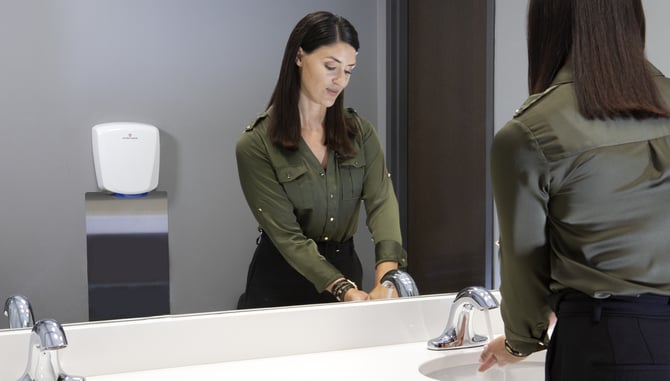What makes more sense?
Choosing the right touchless technology.
When it comes to sensor product actuation, you have two options—solenoid or motor-gear operation. Before we break down the differences, let’s quickly cover the mutual benefits. For the sake of simplicity, we’ll stick to restroom fixtures.
- First and foremost, they’re touchless, whether it’s a faucet or flush valve.
- Both allow users to wash their hands or flush the toilet without physically touching a handle or button, which helps cut down on germ transference and user concerns.
- Both come with low-flow options to reduce water waste.
- Both can be upgraded to connected capabilities, using IoT wireless monitoring for data insights.
- Finally, both typically outlast many manual alternatives.
To sum it up, both are preferred by today’s restroom standards for efficiency and hand hygiene. Now let’s break it down further by taking a look inside the technology.
How Solenoid Sensors Work
Solenoid technology combine an IR sensor, solenoid valve, power source, and electronics module to physically start and stop waterflow, using push/pull movement. Once it senses an object's presence in front of the faucet or flush valve, the solenoid pulls open to initiate the flow of water. When the object is no longer present, the sensor and control electronics push the solenoid valve to terminate the flow of water, but only after a predetermined time has passed.
Another differentiator is the location of the technology. Solenoid valves are positioned in the direct path of the water flow in order to properly sense the user. However, this can be problematic over time as dirt and debris accumulate. When that does occur, the fixture may cease to actuate, which leads to repairs or replacements. All and all, solenoid sensors operate dependably and accurately.
How Motor-Gear Sensors Work
Motor-gear platforms take sensor operation to the next level of performance, making them ideal for high-use commercial restrooms. The dual action of the ceramic disc cartridge and motor-gear operation reduce the moving parts in the water pathway. But it’s much more than working with less. The ceramic disc cartridges wipe against each other in a way that self-cleans and prevents debris buildup. TPE-constructed components, such as the diaphragm, gaskets and seals, resist corrosion. That and all the above allow motor-gear solutions to tack on more years to their lifespan—typically lasting around one million cycles, if not longer.
Added features take the benefits from the maintenance team to the guest experience.
- The technology’s soft close activation creates a seamless, quiet flow.
- The gears turn slowly and steadily, which releases pressure and prevents water hammer. And while water hammer damages the plumbing line (not great), it’s equally negative for the user—no one enjoys loud clanking, flush after flush.
- Motor-gear faucets and flush valves also tend to deliver even greater precision. Their downward and forward angled IR sensors detect users without delay or wasting water.
No matter how you upgrade, you can’t go wrong with touchless solutions—solenoid or motor-gear operation.







